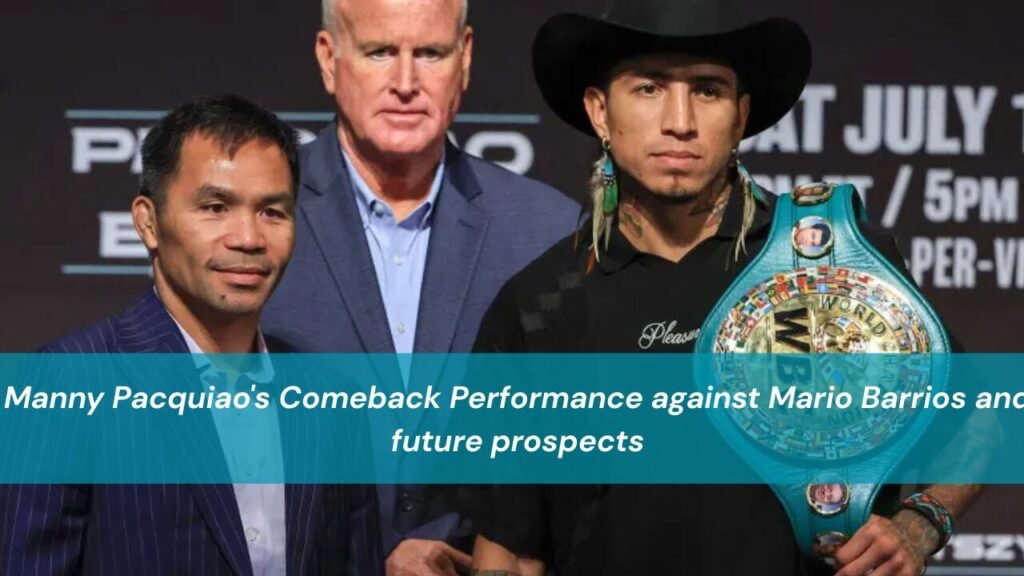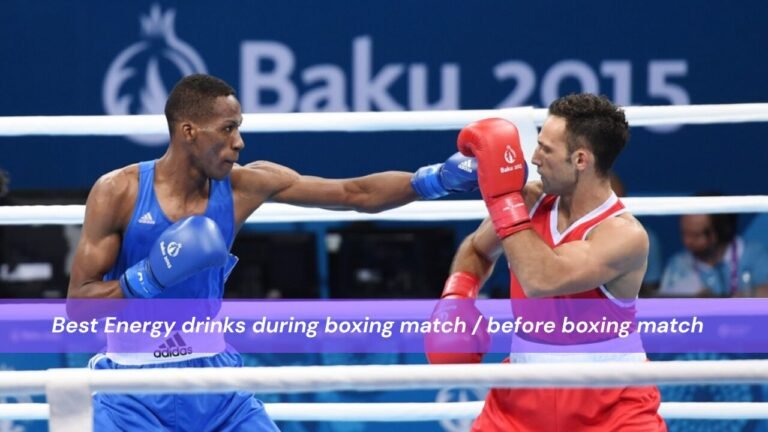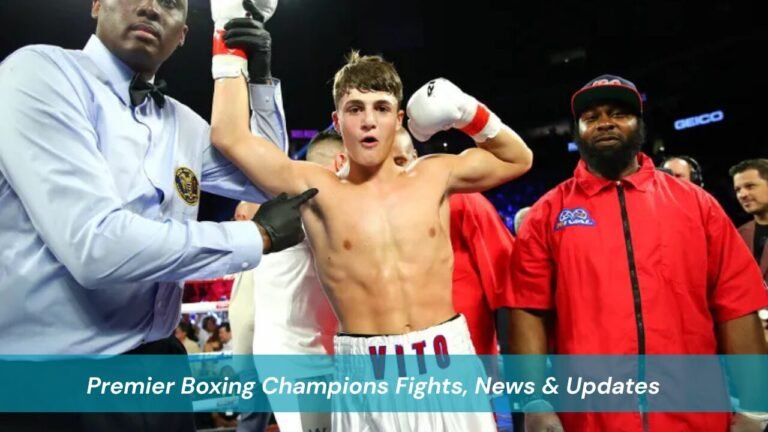In a sport that rarely grants second acts, Manny Pacquiao’s return to the ring at age 46 was both a testament to his legendary status and a sobering glimpse at the limits even the greatest must face. Facing off against Mario Barrios on July 20, 2025, in Las Vegas, the former eight-division world champion hoped to prove that his speed, skill, and ring IQ could still compete at the elite level. Instead, the night became a painful reminder that time is an opponent no fighter can outmaneuver forever.
A Glimpse of the Past, A Reality of the Present
From the opening bell, it was clear Pacquiao retained glimpses of the dynamic explosiveness that once defined his prime. He darted in and out with his trademark flurries and angles, trying to catch Barrios off guard. But Barrios, a 29-year-old WBC interim welterweight titleholder with a 29-2 record and known for his strategic footwork and reach advantage, proved to be a far more difficult puzzle.
Taller, stronger, and with youth on his side, Barrios controlled the distance and consistently landed clean countershots. As early as the third round, Pacquiao’s footwork began to slow, and the once-blinding combinations became easier to read.
The Scorecards Tell the Story
The judges’ unanimous decision in favor of Barrios came as little surprise to those watching ringside. Scores of 117-111, 118-110, and 116-112 painted a clear picture of the night: while Pacquiao remained competitive, he was never truly in control. This wasn’t just a tactical loss; it was physical. Pacquiao’s legendary conditioning once lauded by ESPN analysts and trainers like Freddie Roach was there in flashes, but not sustained. His ability to absorb punishment without slowing had diminished. For fans who watched him dominate the likes of Oscar De La Hoya and Miguel Cotto, this was a quieter, more human version of the icon.
Spirit Over Scorecards
Yet despite the defeat, the night was far from a failure in spirit. The bout drew international attention, with headlines across platforms like Yahoo Sports, Los Angeles Times, and Reuters capturing the emotional gravity of the moment. For Pacquiao, this was never just about belts or rankings. As he told reporters from GMA Network and ABS-CBN News after the fight, “This is for the love of boxing and the love of my fans. I wanted to give them one more fight.”
A Legacy Beyond Wins
Therein lies the paradox of Pacquiao’s return. While his legacy requires no further embellishment having already earned recognition from the International Boxing Hall of Fame and multiple Fighter of the Year awards the decision to return to the ring has reopened questions about his future in the sport. Will he fight again? Should he?
One More Farewell?
Promoters have hinted at the possibility of another farewell bout in Manila or a high-profile exhibition against a fellow retired legend. Some insiders close to Pacquiao, however, believe this could be the final time fans see him in a sanctioned contest. A source from MP Promotions, Pacquiao’s own company, noted that the physical toll of this camp was noticeably harder on the aging fighter, despite his rigorous conditioning program led by renowned coach Justin Fortune.
Context Within the Welterweight Division
Even so, the broader context of his comeback can’t be divorced from the current state of the welterweight division. With Terence Crawford and Jaron Ennis dominating the top tiers according to the WBC and The Ring rankings, there’s little competitive incentive for Pacquiao to chase another title. Mario Barrios himself acknowledged Pacquiao’s courage post-fight, saying in the post-bout press conference, “He’s a legend, and it was an honor to share the ring with him.”
Life Beyond the Ropes
Outside the ring, Pacquiao’s political and philanthropic commitments remain strong. He recently revived talks of a potential 2028 presidential campaign in the Philippines and continues his work through the Manny Pacquiao Foundation, a registered 501(c)(3) nonprofit offering humanitarian support across Southeast Asia. The Foundation has partnered with organizations such as UNICEF and the Red Cross in ongoing relief projects. His visibility remains high, and his influence extends far beyond boxing.
A Fight Worth Having?
Still, fans and analysts will inevitably debate whether the comeback was worth it. In many ways, the Barrios fight adds a final, human chapter to the Pacquiao story less about dominance and more about defiance. It’s a reminder that greatness doesn’t always mean winning. Sometimes, it’s about showing up when you no longer have to.
The Crowd Tells the Truth
As Pacquiao stood in the center of the ring after the final bell, battered but smiling, the crowd’s cheers told the real story. Win or lose, his place in boxing history is untouchable. His legacy isn’t diminished, it’s just grown a little more complex.
Age, Performance, and the Science of Longevity
Pacquiao’s return also reinvigorated conversations around aging athletes and the science behind longevity in high-performance sports. According to a 2024 report from the American Journal of Sports Medicine, fighters over the age of 40 experience a 25% decrease in reaction time and a 30% reduction in punch resistance compared to their younger counterparts. Despite these odds, Pacquiao managed to hold his own against a fighter in his prime, a testament to his extraordinary discipline and training methodology.
Cultural and Economic Ripple Effects
Moreover, the bout sparked renewed interest in boxing across Southeast Asia, with national networks in the Philippines, Malaysia, and Indonesia broadcasting the fight live to millions. The economic impact was notable as well; local gyms saw a 22% uptick in new memberships in the weeks following the match, according to the Southeast Asia Sports Analytics Group. Brands that partnered with Pacquiao—such as Nike Philippines and Gatorade also reported double-digit increases in regional engagement.
Media Attention and Digital Impact
From a media perspective, Pacquiao’s comeback was a ratings success. ESPN, DAZN, and local channels reported significant viewership spikes, with ESPN’s digital viewership breaking 1.5 million during the fight’s peak moments. The fight also trended globally on X (formerly Twitter) and Instagram, underscoring Pacquiao’s enduring relevance in the digital age.
The Mind of a Champion
Beyond his physical performance, Pacquiao’s mental sharpness drew praise. Several analysts noted that his fight IQ remained elite, evident in his ring positioning, feints, and tactical body shots, even if his speed was diminished. In fact, a post-fight breakdown on FightHype highlighted several sequences where Pacquiao baited Barrios into overextending tactics that harked back to his prime strategy.
Endorsements from the Legends
His return also drew commentary from fellow boxing legends. Floyd Mayweather Jr., who defeated Pacquiao in 2015, commented during an interview with Showtime, “Manny still has the heart. No one can question that. And if he wants to do it again, that’s his call. But he’s already done everything a fighter could ever dream of.”
A Hero to the Next Generation
Meanwhile, rising Filipino fighters like Eumir Marcial and John Riel Casimero praised Pacquiao’s courage and viewed the bout as motivational. “He’s still our hero,” said Marcial in a post-fight interview. “Win or lose, he’s the reason a lot of us lace up our gloves.”
A Legacy Evolved
Whether Pacquiao steps into the ring again remains to be seen. What’s certain is that his legacy both as a fighter and public figure has taken on new dimensions. He’s not just a warrior or a politician or a philanthropist. He’s become a symbol of persistence, passion, and the Filipino spirit.
What Comes Next?
As the dust settles from the Las Vegas showdown, analysts and fans alike are left reflecting on what might come next. Exhibition matches? A documentary? A political campaign? Whatever path Pacquiao chooses, it will likely be guided by the same fierce determination that made him a global icon in the first place.
Conclusion
In closing, Pacquiao’s bout with Barrios was more than just a comeback; it was a case study in resilience, the commercialization of nostalgia, and the evolving role of athletes in a media-saturated age. It showed us that while time may dull reflexes, it cannot erase legacy.
FAQs
Why did Manny Pacquiao come out of retirement?
He returned primarily for the love of the sport and to give fans one more fight experience, as confirmed in post-fight interviews with GMA Network.
How did Pacquiao perform against Mario Barrios?
He showed flashes of brilliance but ultimately lost by unanimous decision, as reported by multiple sports news outlets.
Will Pacquiao fight again?
It’s uncertain; some insiders from MP Promotions believe this was his final professional bout.
What are Pacquiao’s future plans?
He may focus on political ambitions and continue his philanthropic efforts through the Manny Pacquiao Foundation.
What did other fighters say about Pacquiao’s comeback?
Legends like Mayweather praised his heart, while younger Filipino boxers found inspiration in his return.




